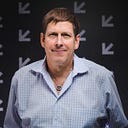Five Reads: Guarding the Truth
The Forrest Four-Cast: December 15, 2018
What follows is our roundup of five of the most compelling stories discovered over the last few days. Look for this column every week in this space.
Who Guards the Truth?
Time magazine made journalists, including the murdered Washington Post columnist Jamal Khashoggi, its 2018 Person of the Year, in part to emphasize the importance of reporters’ work in an increasingly hostile world. Joel Simon, executive director of the Committee to Protect Journalists, said Khashoggi is one of at least 52 journalists murdered so far this year. They report that 2018 “has been marked by manipulation and abuse of information, along with efforts by governments to foment mistrust of the facts.”
Interestingly, the magazine’s runner-up choice was President Trump, who has popularized the concept of “fake news” and called some reporters enemies of the people.
The other “guardians” Time named are the staff of the Capital Gazette in Annapolis, Maryland, where five people were shot to death in June; Philippine journalist Maria Ressa, who has aggressively covered the government of President Rodrigo Duterte; and Reuters reporters Wa Lone and Kyaw Soe Oo, who have been jailed in Myanmar for a year after investigating a massacre of Rohingya Muslims.
A diverse crop of journalists and editors will lead conversations about how to rebuild trust with their audiences, and explore challenges and innovative ideas impacting the way content is produced, distributed and consumed as part of the SXSW 2019 Media and Journalism track.
National Hacking
According to numerous sources, Chinese intelligence-gathering agencies were behind the massive hack that collected personal details of more than 500 million Starwood hotel guests. This discovery throws even more turmoil into the ongoing trade negotiations between the Trump administration and China. The silver lining is that the information hasn’t yet shown up on the darkweb.
In related news, an AP investigation, using information gathered by the London-based cyber security firm Certfa, revealed that a hacking group nicknamed Charming Kitten attempted to break into personal emails of American officials tasked with re-imposing economic sanction on Iran, working closely with the Islamic state. At the very least, this sounds like the basis of a good movie plot.
The Tech Industry and Enterprise track of SXSW 2019 will explore some of the latest developments in cybersecurity, including “Simulating Criminal Hackers to Strengthen Security.”
Sleep, What’s It Good For?
In the New Yorker, Zoë Heller takes on sleep evangelists who try to convince everyone “in contradiction of all the available evidence, that stinting on sleep makes us heroic and industrious, rather than stupid and fat.” She calls out sleep guru Arianna Huffington, author of “The Sleep Revolution, which Heller says, “leaves the misleading and slightly infuriating impression that sleep is a life-style choice, a free resource, available to all who care enough to make it a priority.” In fact, some 40 million Americans suffer from chronic insomnia despite trying all sorts of remedies. In this essay, Heller reviews the new book “Why We Dream,” which encourages readers to think of dreams and sleep as not a mere respite from being awake but a different state of consciousness with intrinsic benefits.
Learn more about harnessing the power of the brain for improved well-being at the Health and MedTech track of SXSW 2019.
Can City Planning Combat Loneliness?
Loneliness isn’t just a drag, it’s a major public health concern. According to studies, the health impact of chronic social isolation is as bad as smoking 15 cigarettes a day.
In Fast Company, Tanzil Shafique reports on leading a graduate design studio at the Melbourne School of Design, in which the students were charged with conceiving of architectural and urban responses to loneliness. Think of the different ways people respond to the environment in an elevator vs. a playground.
One idea was retrofitting a train station with multiple “social engagement paraphernalia” designed to promote conversations and activity. One student “proposed to convert train cars into ‘sensory experience cabins’ that attract people to explore the in-built gallery spaces and listen to other people’s stories while commuting.”
SXSW recently announced the judges for Place by Design, SXSW’s design competition that celebrates the intersection of art, technology, and design as it transforms public space and reimagines how we use and interact with our shared spaces. Artists, architects, designers, and urbanists submit their scalable solutions for improving shared landscapes, and the selected finalists present their work in a fast-paced pitch competition.
What Makes Bruce Tick
Finally, this article was first posted online two weeks ago, but is still worth a long read. Michael Hainey’s portrait of Bruce Springsteen in Esquire serves as a model of in-depth, candid journalism. You wouldn’t think there was more to learn about such an iconic figure, as Springsteen gets set to release his popular Broadway show on Netflix, but Hainey sensitively but deeply explores the musician’s complicated relationship with his father, how he grapples with demons of the past and how he’s changed to be a better dad. “Above all,” Hainey writes, “he speaks with the unveiledness of a man who has spent more than three decades undergoing analysis — and credits it with saving his life.”
Speaking of the Boss, his magical Keynote Presentation from SXSW 2012 will leave you inspired and amazed.
Five Reads Archive
December 5: Becoming an Obama
November 30: The Trouble for Juul
November 21: Life Is Good
November 16: Whither Facebook
November 9: Why Does the US Love Guns?
November 2: Ester Perel Knows Love
Hugh Forrest serves as Chief Programming Officer at SXSW, the world’s most unique gathering of creative professionals. He also tries to write at least four paragraphs per day on Medium. These posts often cover tech-related trends; other times they focus on books, pop culture, sports and other current events.
